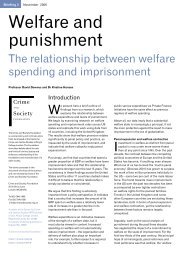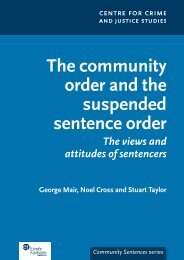PRISON SERVICE
PRISON SERVICE
PRISON SERVICE
- No tags were found...
You also want an ePaper? Increase the reach of your titles
YUMPU automatically turns print PDFs into web optimized ePapers that Google loves.
ReviewsBook ReviewThe Dynamics of Desistance:Charting Pathways throughchangeBy Deidre HealyPublisher: Willan Publishing (2010)ISBN: 978-1-84392-783-9(hardback)Price: £40.00 (hardback)The Dynamics of Desistance ispart of a series of publications beingled by Sheffield University’s StephenFarrall, examining issues connectedwith desistance and rehabilitation.The source material for the book isbased on a Phd study of 73 maleprobationers in Dublin, making thebook very much a genuine piece ofresearch rather than a referencebook. Potential readers may be putoff by the fact that this is, in effect,an international study, by a relativelyunknown academic but this wouldnot do the study or the authorjustice. This is a very well writtenpiece both in terms of its eruditereview of surrounding literature andthe learning and discussion thatHealy draws from her work. If youwant to find out about desistancetheory read the opening chapters; ifyou want to expand your knowledgein this rapidly developing area ofwork read the whole book.Desistance theory is nowstarting to emerge as a new methodof inquiry into the discovery ofreasons why offenders cease tocommit crime, and brings a newdimension to the current emphasison what has become the ‘whatworks paradigm’. The book usesphenomenological accounts of thepsychosocial processes involved indesistance from crime. The studygroup is tracked over a four yearperiod and research methods use indepth interviews with participantsand those working with them. Thisapproach compliments some of theearly work in this area by authorssuch as Shadd Maruna and FergusMcNeill.Healy uses a combination ofquantitative and qualitative methodsto explore and describe theattitudes, motivations andbehaviours of participants to trackthe transition to crime free life.Desistance theory breaks awayfrom the more traditional (and oftenblack and white) description ofchange that characterises the ‘whatworks’ approach, adding greaterdepth to our understanding ofemotional experiences andmotivation for change. Thisapproach allows us to put intocontext some of the ambiguitiesassociated with study in this area,including the transient or eventurbulent nature of giving up crime.I particularly enjoyed the sharpinsight that Healy has, the way thatshe attempts to reconcile competingapproaches and track the history andoften complex issues that arise indesistance theory. The book beginswith a very constructive and wellwritten overview of the currentliterature which is skilfully set incontext and sets the scene for somevery detailed enquiry into individualclient experiences. This narrativeapproach to studying behaviour andoutcomes, very much championedby Maruna in his now seminal pieceset in Liverpool, is to some extentchallenging what has become Anover simplified approach to servicedelivery for resettlement andrehabilitation of offenders builtaround what is commonly describedas the 7 pathways. Conventionalwisdom suggests that offenders willnot give up crime, or at least bevulnerable to re-offending, whilstthere are ‘unmet needs’ within oneor more of the pathways, not leastin terms of attitudes to crime.Desistance theory starts to broadenout this thinking by examining thereal experiences of offenders as theygive up crime, and often concludingthat Desisters will find their ownpath to crime free lives. This is not tosay that the core social issues such asaccess to secure housing, a source oflegitimate income and familysupport are not important, it is theway that these issues affect the livesof offenders is important, it is thisnarrative that desistance theoristsseek to draw out.Healy, in common with McNeiland champions of this newapproach suggest that we need tospend more time looking at socialengagement and develop greaterunderstanding of the concept of‘human capital’ and how it isexercised. New concepts emerge likethe extent to which ‘self belief’ and‘acceptance’ play a major part inreform. This approach helps to givealternative explanations of whysome approaches which do appearto deliver results may do so forentirely different reasons:Ian, who got out of prison earlyon review [early release], describedhis experience when he had to talkabout his offence in a group basedcognitive-behavioural programmefor the first time. For him, it was notjust a matter of dealing with hisfeelings about the offence, but alsothe acceptance he received fromboth staff and fellow participantsafter revealing his crime. (p. 141)Desistance theory placessignificant emphasis on ‘personalconnection’ and relationships,offenders become ‘ex-offenders’when they label themselvesdifferently. In this way Healy is ableto draw out how identity is oftenmore important than other factorswhich lead to being able to livecrime free.Because the study group areprobationers, she also provides anaccount of the relationship andissues that arise in relation tosupervision. She gives factors that60 Prison Service JournalIssue 192











